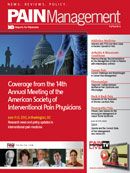Buprenorphine's Complex Pharmacology Presents Several Challenges for Prescribers
Properties that enable applications in both pain management and addiction medicine make buprenorphine unique among opioids.
During his presentation, titled “Buprenorphine in Pain and Chemical Dependency,” delivered Sunday at the 2012 annual meeting of the American Society of Interventional Pain Physicians (ASIPP), Sanford Silverman, MD, Medical Director and CEO of the Comprehensive Pain Medicine clinic, in Pompano Beach, FL, discussed several unique aspects of the pharmacology of buprenorphine and outlined its uses in pain management and opioid dependence.
Silverman noted that buprenorphine is a highly potent synthetic opioid that has a rapid onset of action (30-60 minutes in sublingual form) and dose-related duration of action, with an elimination half-life of about 37 hours. Buprenorphine is a partial agonist at mu-opioid receptors and an antagonist at kappa receptors. Silverman said that buprenorphine has a high affinity for the mu-receptor, “binding more tightly to these receptors than other opiates or opiate antagonists,” and demonstrating slow dissociation from the receptor with milder withdrawal. Buprenorphine has very poor oral bioavailability, but excellent sublingual and transdermal bioavailability.
Although buprenorphine is available in several preparations (sublingual tablets, transdermal patches, sublingual film, intramuscular injection, intravenous administration), only the sublingual formulations are approved for treating opioid dependence. Silverman reminded the audience that it is actually illegal to use the transdermal patch, intravenous, and intramuscular injection preparations of buprenorphine to treat opioid dependence. Buprenorphine is also the only schedule III drug for the treatment of opioid dependence. Silverman told the audience that although prescribers need to undergo special training and obtain a federal waiver to treat patients for opioid dependence with buprenorphine, they do not need a waiver to use this medication when managing chronic pain.
Other aspects of buprenorphine pharmacology and use of buprenorphine in treatment touched on by Silverman during his presentation:
- Safety — buprenorphine is well tolerated and has a high therapeutic index. It has a relatively lower risk of abuse compared to other opioids.
- Withdrawal — Because of buprenorphine’s high affinity for mu-opioid receptors and lower intrinsic opioid activity than full agonist opioids, patients given buprenorphine while still experiencing the effects of other opiates will experience opioid withdrawal (Silverman referred to this as “precipitated withdrawal”).
- Acute Pain Management — Maintenance therapy with sublingual buprenorphine will not treat a patient’s acute pain. Patients on buprenorphine who require treatment for mild to moderate acute pain (eg, having a tooth extracted) can be treated with additional sublingual buprenorphine, non-opioid analgesics, or short-acting opioids. Silverman recommended that patients who require treatment for moderate to severe acute pain (eg, major surgery such as knee replacement) should have their buprenorphine discontinued 24-28 hours prior and be treated with opioids. Buprenorphine therapy can be re-initiated after the pain subsides.
- Opioid-induced Hyperalgesia and Chronic Pain Syndrome — Because buprenorphine is a kappa-receptor antagonist, it “may be of benefit in treating both of these entities,” according to Silverman.
- Converting between Formulations — There are no established ratios for converting from sublingual buprenorphine to the transdermal patch preparation. Silverman recommended that clinicians consider converting only in patients who are on low doses of sublingual buprenorphine (2 mg or less per day)
